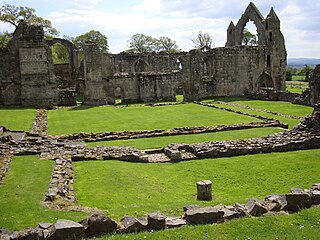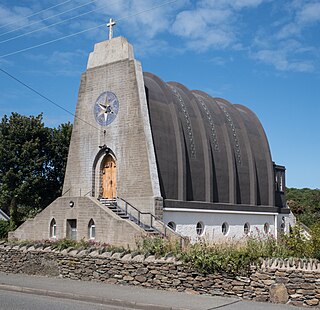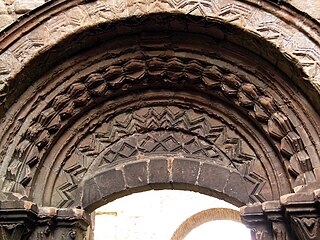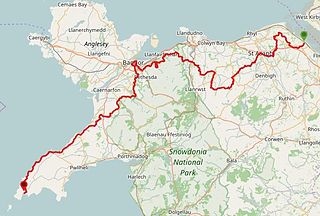
Oswestry is a market town, civil parish and historic railway town in Shropshire, England, close to the Welsh border. It is at the junction of the A5, A483 and A495 roads.

The Abbey Church of the Holy Cross is an ancient foundation in Shrewsbury, the county town of Shropshire, England.

Saint Winifred was a Welsh virgin martyr of the 7th century. Her story was celebrated as early as the 8th century, but became popular in England in the 12th, when her hagiography was first written down.

St Winefride's Well is a holy well and national shrine located in the Welsh town of Holywell in Flintshire. The patron saint of the well, St Winefride, was a 7th-century Catholic martyr who according to legend was decapitated by a lustful prince and then miraculously restored to life. The well is said to have sprung up at the spot where her head hit the ground. This story is first recorded in the 12th century, and since then St Winefride's Well has been a popular pilgrimage destination, known for its healing waters. The well is unique among Britain's sacred sites in that it retained a continuous pilgrimage tradition throughout the English Reformation.

Snailbeach is a village in Shropshire, England, located near Shrewsbury at grid reference SJ375025. The population details taken at the 2011 census can be found under Worthen. The village was formerly home to a large lead mine.

William La Touche Congreve, was an English recipient of the Victoria Cross, the highest and most prestigious award for gallantry in the face of the enemy that can be awarded to British and Commonwealth forces.

Haughmond Abbey is a ruined, medieval, Augustinian monastery a few miles from Shrewsbury, England. It was probably founded in the early 12th century and was closely associated with the FitzAlan family, who became Earls of Arundel, and some of their wealthier vassals and allies. It was a substantial, successful and wealthy house for most of its four centuries, although evidence of abuses appeared before its dissolution in 1539. The buildings fell into disrepair and the church was largely destroyed, although the remains of some of the domestic buildings remain impressive. The site is now in the care of English Heritage and is open to the public throughout the year and free entry.

Great Ness and Little Ness are civil parishes in Shropshire, England.

Maesbury is a small scattered community in Shropshire, England, south of the town of Oswestry, falling within the Oswestry Rural parish.

Llanfyllin is a market town and community in Powys, Wales. The community population in 2021 was 1,586 and the town's name means church or parish (llan) of St Myllin. The community includes the settlements of Bodfach, Ty Crwyn, Abernaint and several farms.

A Morbid Taste for Bones is a medieval mystery novel by Ellis Peters set in May 1137. It is the first novel in The Cadfael Chronicles, first published in 1977.

Our Lady Star of the Sea and St Winefride is a Roman Catholic church in Amlwch, a town on the island of Anglesey, north Wales. It was built in the 1930s to a design by an Italian architect, Giuseppe Rinvolucri, using reinforced concrete. The church is in the shape of an upturned boat, reflecting Amlwch's maritime heritage, and is dedicated to Our Lady, Star of the Sea and St Winefride, a Welsh saint.

Dudleston Heath is a village in north-west Shropshire, England. It is located on the B5068 road between Ellesmere and St Martin's and is part of Ellesmere Rural civil parish. The Wales-England border is just to the north.

The Cambrian Railways works is a former railway engineering building located in Oswestry, Shropshire.

The White House in Aston Munslow, Shropshire, England is a medieval hall house that has undergone considerable alteration over the centuries. It is a grade II* listed building.

Christ Church, Welshpool was commissioned by the Earl of Powis to commemorate his son, Edward James, the Viscount Clive, having come of age. It was designed by Thomas Penson and completed 1839–44. The church is characterised by its impressive Romanesque Revival architecture in volcanic Trachyte from the Earl of Powis' Standard quarry in Welshpool. The church consists of a 7-bay nave with offset west tower, aisles, apse and south porch. The west gable of the nave has a wide doorway with triple arches with chevron moulding, while the tower is supported by massive pilaster buttresses. Christ Church was most noted for its interior decoration, and in particular its early use of terracotta. The church was a Chapel of Ease of Welshpool's St Mary's Church and had a separate endowment. It cost £6000 to build and this was raised by public subscription as well as being supported by the Earl. The congregation of Christ Church dropped dramatically during the twentieth century and in 1998 it was closed and sold in 2002 to Karl Meredith and Natalie Bass who are in the process of restoring the church, partly as a house and partly for community use.
Saint Dyfnog was an early Welsh saint. His feast day is 13 February.

John Mirk was an Augustinian Canon Regular, active in the late 14th and early 15th centuries in Shropshire. He is noted as the author of widely copied, and later printed, books intended to aid parish priests and other clergy in their work. The most famous of these, his Book of Festivals or Festial was probably the most frequently printed English book before the Reformation.

Robert of Shrewsbury or Robertus Salopiensis was a Benedictine monk, prior and later abbot of Shrewsbury Abbey, and a noted hagiographer.

The North Wales Pilgrim's Way is a long-distance walking route in North Wales, running from near Holywell in the east to Bardsey Island in the west. The first half of the trail takes an inland route, with the second half following the north coast of the Llŷn Peninsula. It measures 133.9 miles (215 km) in length, and was officially launched at Porth y Swnt, Aberdaron on 10 July 2014.






















